This journal brought to you by:
- Toya Jackson and her 4th grade students
- St. Ann 'Sparks' 5th graders
- Bailey Station 4th grade APEX
 Thank you - Jackson Elementary, St. Ann and Bailey Station.
Thank you - Jackson Elementary, St. Ann and Bailey Station.
An Icy Interlude
Antarctica is a place that knows ice! But not all ice is the same. In fact there are many different types of ice, all with interesting facets.
Let's start large...
Glaciers
One word you hear a lot when referring to ice down here is glaciers. Glaciers are constantly moving, masses of ice. They are created when snow accumulates in layers and the pressure of all of these layers along with the influence of gravity causes the mass to move very slowly!
Check out this diagram to show you how glaciers are formed. It takes a long time, but all of those layers of snow build up causing pressure on the bottom layers.
Take a look:
 How glacier ice forms. Image credit: Frozen in Motion by Katherine Hocker.
How glacier ice forms. Image credit: Frozen in Motion by Katherine Hocker.
 See the lines in the snow? These lines show the movement of glaciers. Photo by: Corey Anthony/National Science Foundation
See the lines in the snow? These lines show the movement of glaciers. Photo by: Corey Anthony/National Science Foundation
Types of Glaciers
There are two major types of glaciers: alpine glaciers that occur in some mountainous areas and continental glaciers that cover wide areas. Ice sheets and ice shelves are two types of continental glaciers. Let's take a closer look at those...
Ice sheets:
All over the continent there are vast expanses of ice called ice sheets. An ice sheet is a (VERY!!) thick slab of ice that covers more than 50,000 km2 (19,000 sq mi)! Ice sheets can be found in two places: Antarctica and Greenland. About 90% of Earth's fresh water is held in ice sheets.
The ice sheet in Antarctica covers the entire continent and is divided by the Transantarctic Mountains. The right side is called the West Antarctic Ice Sheet (WAIS) and East Antarctica Ice Sheet (EAIS).
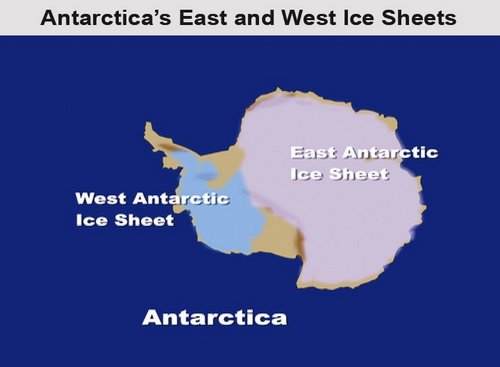 Antarctica's East and West Ice Sheets. Image credit: ambrosevideo.com
Antarctica's East and West Ice Sheets. Image credit: ambrosevideo.com
Ice Shelves:
In addition to ice sheets, there are also ice shelves. Ice shelves are thick, floating platforms of ice that forms where an ice sheet or glacier flows down to a coastline and onto the ocean’s surface. Take a look at the diagram below. You can see that the ice shelf is still attached to the ice sheet, but it is hanging over the edge into the ocean.
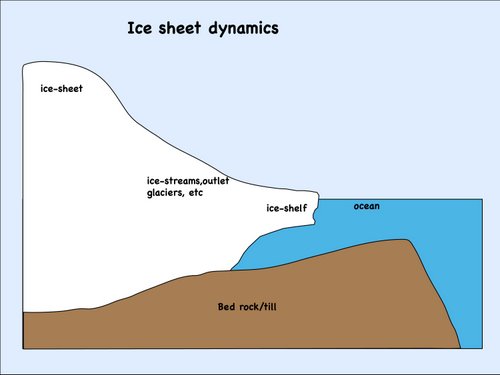 Ice sheet dynamics. Image credit: University of Chicago Department of Geophysical Sciences
Ice sheet dynamics. Image credit: University of Chicago Department of Geophysical Sciences
Ice shelves can be found in Antarctica, Greenland, and even in some parts of Canada.
An easy way to remember
Sometimes I get the two terms confused - so here's an easy way to remember.
Think of how you use you a sheet and a shelf at home. You put a sheet on your bed, something solid; while a shelf sticks out from the wall. The same thing is true for ice sheets and ice shelves. And ice sheet is on something solid - the continent; while the ice shelves stick out from the continent - kind of like a shelf. Thanks Gary for showing me this little trick.
Sea Ice
The types of ice I talked about above you find on land. However, it is a whole different world when you talk about ice in the water. Sea ice is frozen seawater. Almost all of the Antarctic sea ice is 'seasonal ice,' meaning it melts away and reforms annually. This sea ice is formed from the salt water around Antarctica and salt water freezes differently than the water on land - which is fresh water. The process where the salt water freezes can cause all different types of ice.
Here are a few of my favorites...
Frazil ice
Did anyone order a slushie? – Sea ice growth begins with frazil ice and it gets its name from its loosely packed crystals, so it has a slushy appearance. In fact, if you have ever had an ICEE, that's pretty close to drinking frazil ice!
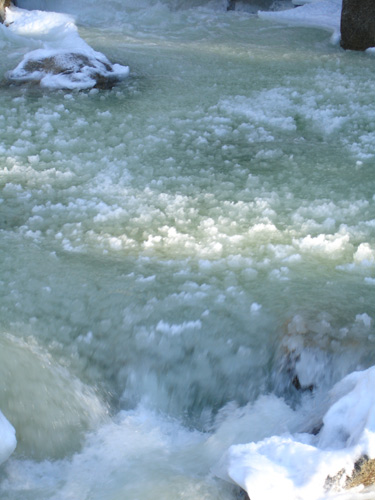 Frazil ice from Yosemite National Park. Can you see how the ice appears to have a slushy look. Photo credit: lifeinyosemite.com
Frazil ice from Yosemite National Park. Can you see how the ice appears to have a slushy look. Photo credit: lifeinyosemite.com
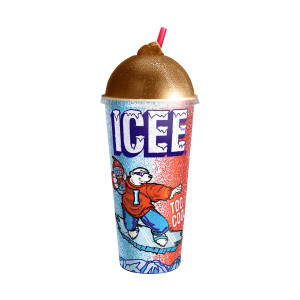 I think I'd rather drink this one! Image credit: polyvore.com
I think I'd rather drink this one! Image credit: polyvore.com
Grease ice
Grease ice is a thicker, 'soupier' version of frazil ice. This ice looks like grease on top of the water – hence its name. Again, the crystals here are loosely packed, making it more fluid than more frozen ice, but it the crystals are more packed than frazil ice.
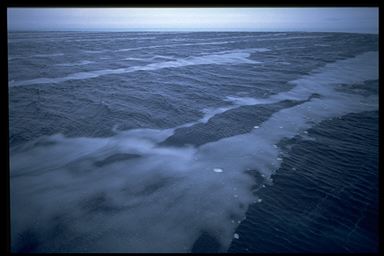 See how the ice appears to have a sheen that looks like grease. Photo credit: Geophysical Institute at the University of Alaska Fairbanks.
See how the ice appears to have a sheen that looks like grease. Photo credit: Geophysical Institute at the University of Alaska Fairbanks.
Pancake ice
No griddle required – When ice from the ocean begins to freeze more, it packs closer together creating little disks called pancake ice. These aren’t the pancakes we douse in syrup, but look like small circles floating on top of the water. Take a look at the edges of the pancakes. These raised edges are created because the pancakes have been battered into each other by waves and collisions.
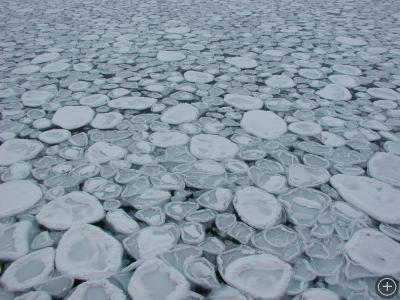 It’s like an All-You-Can-Eat 'Pancake ice' buffet! Photo credit: icestories.exploratorium.edu
It’s like an All-You-Can-Eat 'Pancake ice' buffet! Photo credit: icestories.exploratorium.edu
Pack ice
Pack ice is ice that is not attached to the shoreline and drifts in response to winds, currents, and other forces; some prefer the generic term drift ice, and reserve pack ice to mean drift ice that is closely packed.
Fast ice
Fast ice (sometimes called land-fast ice) is anchored along the coast or shallow parts of the ocean bottom. Unlike pack ice, fast ice does not move with the winds or currents.
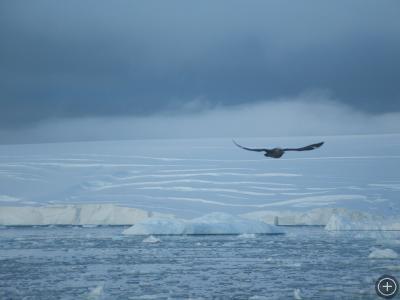 Fast ice is a type of sea ice that isn’t really speedy—it’s 'stuck fast' to land. Photo credit: icestories.exploratorium.edu
Fast ice is a type of sea ice that isn’t really speedy—it’s 'stuck fast' to land. Photo credit: icestories.exploratorium.edu
Icebergs
The last (and probably most famous) type of ice that I will talk about today is icebergs. Icebergs are large pieces of ice that have broken off from a glacier or ice shelf and are floating in the water. So even thought the iceberg is floating in sea water it was not formed from frozen sea water - but freshwater from a glacier or ice shelf.
Have you ever heard the expression 'that's just the tip of the iceberg'? That phrase is typically used to describe a small visible problem that is hidden by a much larger one. And, we have the 'real' icebergs to thank for that. Because of the density differences between pure ice and sea water only about one-ninth of the volume of an iceberg is above water. WOW! The largest part of the iceberg is below water! Icebergs can be breathtakingly beautiful and to think that the majority of the iceberg we can’t see above the water!
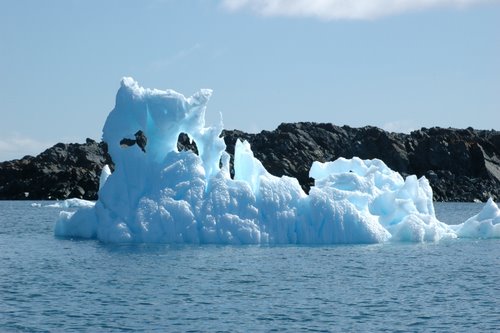 Take a look at this iceberg! It has a very unique shape it. What does it look like to you? Photo by Peter Rejcek/National Science Foundation
Take a look at this iceberg! It has a very unique shape it. What does it look like to you? Photo by Peter Rejcek/National Science Foundation
